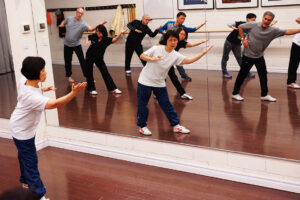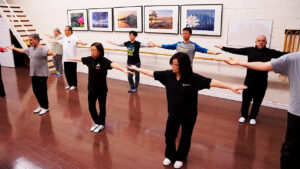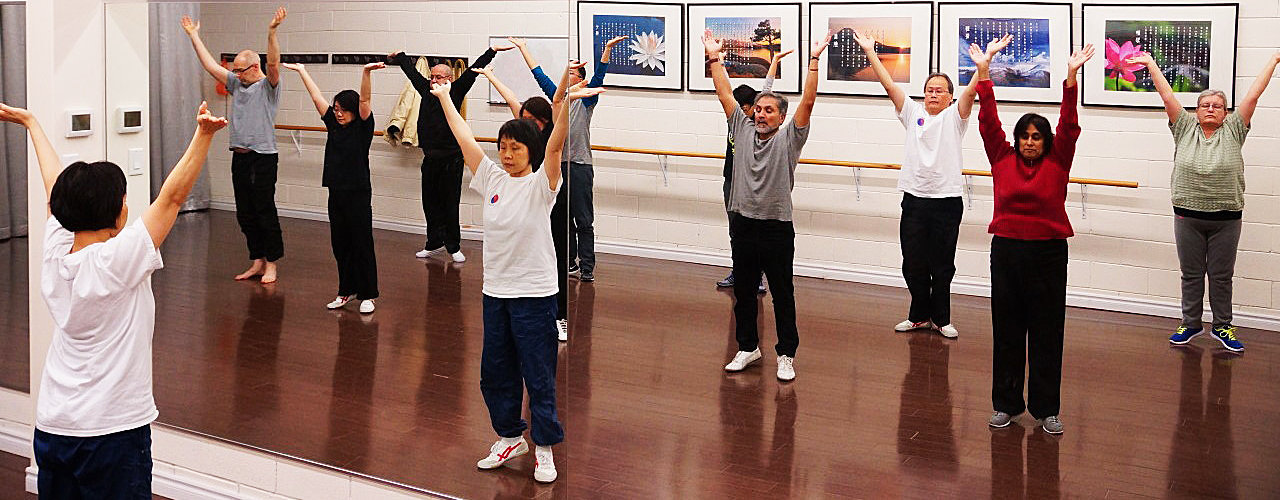As both tai chi and qi gong become more popular, more and more people want to understand the difference and be able to explain it to others. Firstly, this is no easy task because there are many different types of qi gong with hundreds of styles and 5 major schools of tai chi with many variations within each.
Tai chi and qi gong are two very different disciplines. It’s like comparing dance with aerobics. Both dance and aerobics involve movement coordinated with music and are good exercises for the body. However their intents are very different. Tai chi and qi gong also appear similar because they involve slow movements and provide a host of health benefits. However, again the intent of qi gong and tai chi are different.
The Focus of Tai Chi & Qi Gong

Because qi gong is a 3,000 year old practice and tai chi is a 300 year old practice, the challenge is understanding the history of each modality, the developmental path of each style as well as the nuances in translating the words used in Chinese to explain movement philosophies. The philosophies are written like poetry and often there are no one-to-one translations into English words, so vocabulary which approximates the Chinese words are often used but lack the depth of meaning.
Qi Gong contains the word “qi” (pronounced chi) for energy or the force found in everything in the universe. “Gong” means a skill developed through steady practice. So, qi gong is typically translated as “life energy cultivation”.
On the other hand, tai chi is the shortened version for actual name of the martial art taijiquan or tai chi chuan, yet another spelling of taijiquan. Although the word “chi” in tai chi is spelt like the word energy, it actually represents quite a different word. The more accurate Mandarin pinyin spelling would be “ji” as in taijiquan and it is pronounced “gee” which means “ultimate”. So, altogether, taijiquan means “supreme ultimate fist”. Even though the name clearly reflects its martial arts origins, the health benefits are still astounding.
The Qi Gong vs. Tai Chi Class Experience
 The practicing of qi gong and tai chi are similar in that they are based on a series of movements to achieve the health and movement benefits. However, the in-class experience is quite different.
The practicing of qi gong and tai chi are similar in that they are based on a series of movements to achieve the health and movement benefits. However, the in-class experience is quite different.
The qi gong class experience feels more like an exercise or a slow motion aerobics class in that each movement is repeated several times. The purpose of a qi gong form is to work the meridians of the body. Some types of qi gong require movement to activate a meridian as defined by TCM (Traditional Chinese Medicine). The movement is repeated several times to improve circulation, accomplish the appropriate energy flow through the meridian and achieve the appropriate stretch of muscles, tendons or ligaments.
 People find the classes peaceful, yet a good work out too. More sensitive people feel a flow throughout their body. Whether someone considers it improved circulation or the flow of qi energy throughout the body, the health and mental benefits remain the same.
People find the classes peaceful, yet a good work out too. More sensitive people feel a flow throughout their body. Whether someone considers it improved circulation or the flow of qi energy throughout the body, the health and mental benefits remain the same.
On the other hand, when attending a typical tai chi class, the class will resemble a dance class. The intro class teaches basic techniques so you will know the basic moves and techniques much like learning some basic dance moves before learning to string all the moves together into a full choreographed dance.
After the intro class, people choose a tai chi form that would best suit their own personal style. Chen style is the original style and the movements are more active. Yang style is the more popular style these days and has a smoother flowing style to the entire form with gentle movements. Don’t be fooled though, it is a good work out and keeps people both healthy in body and mind.
Within each style, people learn all the steps of the form from the beginning to the end. Just like a choreographed dance, a set of movements or a variation may re-appear within the sequence. And, unlike an exercise class, it’s not repeated 10x in a row.
If you’re looking for a fusion of both experiences, try the Tai Chi Fitness class for people looking for more of an exercise style class to achieve all the postural benefits and core strength of tai chi.
The Different End Results of Qi Gong and Tai Chi
 There are different types of Qi Gong, some are static and some are dynamic. Tai Chi comes with different family styles, and within each style there may be variations.
There are different types of Qi Gong, some are static and some are dynamic. Tai Chi comes with different family styles, and within each style there may be variations.
Qi Gong is primarily an exercise for health which aligns with TCM and meridians with exceptions to certain forms. In qi gong, the repetitive nature and the unique stretch and strengthening positions will target multiple parts of the body and people feel more calm, relaxed and flexible after a class of qi gong.
To develop balance and posture, tai chi is ideal. The martial arts origin of tai chi means that the movements are focused on maintaining postural alignment throughout. A person who has accomplished good postural alignment doesn’t fall off balance easily and the martial artist who is masterful at posture and balance will not be moved from that balance and alignment even during a struggle. In martial arts, the philosophy is to achieve an efficiency of movement and move one’s body with maximum power and speed without compromising one’s centre of balance.
One of the key philosophies of tai chi is for the practitioner to become so accomplished at maintaining balance and moving in complete alignment at all times that a person can “move a thousand kilos with 4 ounces” at a moment’s notice. Now, most of us will never achieve this level of mastery but whether you’re an athlete looking to draw more power from better biomechanics or you’re an older person looking to maintain a strong core and balance, tai chi is a fun and social way to become surprisingly stronger and more balanced.
Qi Gong and Tai Chi are Both Done Slowly but for Different Reasons
 Even though qi gong is mainly focused on health and tai chi is mainly focused on martial arts training, each still needs to be practiced slowly for its own unique reasons.
Even though qi gong is mainly focused on health and tai chi is mainly focused on martial arts training, each still needs to be practiced slowly for its own unique reasons.
Qi Gong cultivates qi or energy flow. Our energy or meridian flow needs to be cultivated by slow movements to show our bodies how to open the pathways and retrain the pathways. Also, physiologically muscles and even more so tendons and ligaments take time to learn how to untangle themselves so our circulation and qi can flow strongly.
When we want our bodies to be pain free, qi gong helps us move slowly so we are giving our bodies the time to use and heal the pathways of our body’s meridians. When we add a bit of mindfulness, our body’s energy pathways open and start to unwind from the contortions of many years of sitting or standing on our feet all day.
On the other hand, tai chi teaches our bodies proper balance, posture, alignment and efficiency of movement. The movements are purposeful and aimed at being centred at all times. Tai chi practice is slow to provide a deep programming to our muscles so the body learns how to position itself at every moment and it is never over exerted or unbalanced.
To understand this better, try walking slow motion across the room. It is much harder to do than we might think. All the small imperceptible imbalances are hidden with the momentum of speed when we walk without thinking about it. When we slow that motion down, we start wobbling around because all the imbalances can no longer be hidden.
Learning tai chi means that our body gains the muscle memory of how to move so we are always balanced. We start using more of our postural muscles and they become stronger. This relieves the stress we place on the phasic or movement muscles which become stiff and painful when we’ve been sitting or standing with poor posture all day long.
Learn More about Qi Gong and Tai Chi
The most important thing is that qi gong and tai chi are social practices based around a community of people who are all looking to learn and live better. It is fun.
To learn more about both qi gong and tai chi, read about qi gong and tai chi at our website. It provides more details and not just a comparison. Meet with the teachers, attend an open house to visually experience qi gong vs. tai chi. Finally, take a trial class. Nothing beats experiencing the differences firsthand.

